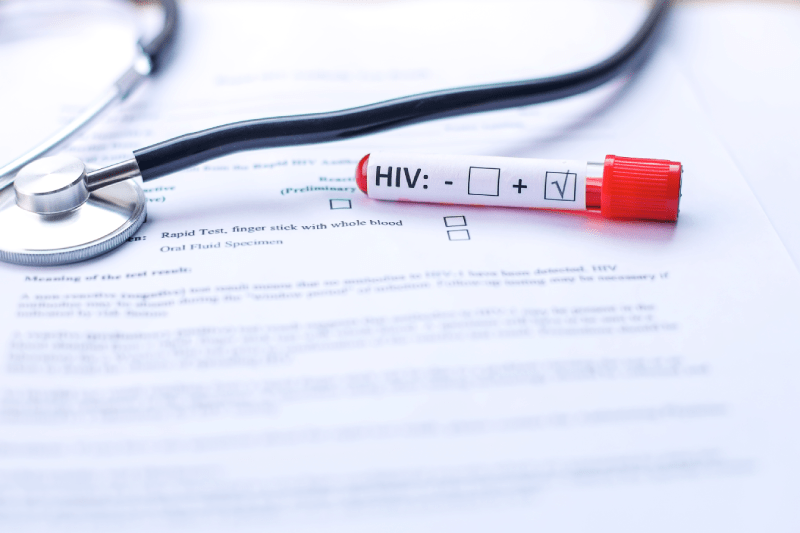HIV Treatment and Current Management Approaches
This content addresses the current treatment, management, and potential approaches to HIV infection that are currently in the research stage. It must be remembered that it is of great importance for all HIV-positive individuals to maintain their follow-up and treatment through specialist centers that adhere to international guidelines.
How Exactly Does Antiretroviral Therapy (ART) Work?
Antiretroviral Therapy, or ART for short, is a combination of powerful drugs that inhibit the HIV replication cycle at different stages within the body. It works by targeting the enzymes (such as reverse transcriptase, protease, and integrase) that enable the virus to integrate its genetic material into the host cell’s DNA. This inhibition significantly reduces HIV’s ability to damage healthy immune cells, particularly CD4 T cells. The regular and complete use of this treatment lowers the amount of virus in the blood (viral load) to undetectable levels, which both protects the individual’s immune system and eliminates the risk of transmission.
What Is The Latest Point Reached In Treatment?
The latest point reached in HIV treatment is not about completely eradicating the virus from the body, but rather making it manageable like a chronic illness. Today’s ART regimens have become simple, effective, and have very few side effects, often combining multiple medications into a single tablet. The success of the treatment is so high that the life expectancy of an HIV-positive individual who takes their medication regularly is almost the same as that of an HIV-negative person. Furthermore, new formulations, such as long-acting injectable ART, have been approved and introduced, reducing the frequency of pill intake to monthly or bimonthly periods.
When Should Someone Newly Diagnosed Start Treatment?
Internationally accepted modern medical guidelines recommend that every newly diagnosed individual should start treatment as soon as possible, without delay. While it was previously common to wait until the CD4 cell count dropped below a certain level, the “Wait and See” approach has been abandoned today. Starting treatment early minimizes damage to the immune system, better controls the viral reservoirs, and most importantly, allows the person to quickly achieve an “Undetectable = Untransmittable (U=U)” status, effectively eliminating the risk of transmitting the virus to others.
What Is The Preparation Process For Starting Treatment?
Before starting treatment, the individual’s general health status, coexisting conditions, and any current medication use are thoroughly examined. During this process, the baseline viral load and CD4 cell count are measured, and screening for other infections like Hepatitis B and C is performed. Based on these test results and the individual’s specific situation, an ART regimen is determined, either as a single tablet or a combination. These regimens are carefully selected to avoid potential drug interactions and ensure maximum adherence. Treatment is initiated only after the individual receives comprehensive education on correct drug use, potential side effects, and the importance of regular follow-up appointments.
Why Is Treatment Adherence Crucial?
Treatment adherence (meaning taking the medication every day, at the correct time, and at the correct dosage) is the most critical factor in HIV management. Irregular intake of medication causes the drug level in the blood to drop, allowing the virus to escape drug suppression. This leads the virus to change its structure and develop resistance to the current ART drugs. Once drug resistance occurs, the effectiveness of that regimen ends, and the individual must switch to a new treatment regimen that is more complex, more expensive, and potentially has more side effects. Consistent adherence ensures the viral load remains at an undetectable level.
What Are The Risks Of Not Taking Medications Regularly?
Failing to take medications or using them irregularly primarily creates a breeding ground for viral replication and the development of drug resistance. Drug resistance can lead to the complete failure of the current treatment. Furthermore, the uncontrolled increase in viral load causes a rapid decline in CD4 cells within the immune system. This leaves the individual vulnerable to opportunistic infections and AIDS-related illnesses, severely threatening their quality and length of life. Treatment interruption also raises the risk of viral transmission again.
What Is Viral Load And How Is It Related To Treatment?
Viral load is a measurement that expresses the number of active HIV RNA copies per milliliter of blood. It is the key indicator determining treatment success and the risk of infection transmission. With effective ART, the viral load typically drops below 20 to 50 copies/ml, a state known as undetectable viral load. Maintaining the viral load at an undetectable level through treatment is critical for the immune system to repair itself and for the individual to remain healthy. A high viral load indicates that the virus is actively replicating and poses a threat to the immune system.
What Does The “Undetectable = Untransmittable” (U=U) Principle Mean?
The “Undetectable = Untransmittable” (U=U) principle is one of the most important scientific triumphs of HIV treatment. This principle states that an HIV-positive person who has maintained a consistently undetectable viral load for at least six months through effective ART treatment will not transmit the virus to their partner through sexual contact. This scientific evidence has provided great psychological relief for HIV-positive individuals and has significantly helped in reducing HIV-related stigma. U=U represents the highest level of success in infection management achieved through regular medication adherence.

What Are The Possible Side Effects That May Be Encountered During Treatment?
Modern ART regimens have far fewer and more manageable side effects compared to older medications. Commonly encountered side effects initially may include mild nausea, diarrhea, fatigue, or dizziness, but these usually disappear as the body adjusts to the medication within the first few weeks. More rarely, some older drugs could cause lipodystrophy (changes in fat distribution) or changes in kidney/liver function. Today’s regimens have greatly reduced these risks, and all side effects are closely monitored with regular laboratory tests.
What Can Be Done To Manage And Minimize Side Effects?
To manage mild side effects experienced at the start of treatment (e.g., stomach discomfort), simple adjustments like taking the medication with food or at a different time of day may be sufficient. When persistent or bothersome side effects occur, it is important to share this with the specialists managing the care. Specialists may suggest additional medication to mitigate the side effect or decide to switch to a different ART regimen if necessary. It is absolutely not recommended to stop the medication or reduce the dose on one’s own due to side effects, as this can lead to resistance development.
For Whom Are Single Tablet Regimens Suitable?
Single Tablet Regimens (STRs) are formulations where multiple antiretroviral drugs are combined into a single pill. Due to the ease of maximizing treatment adherence, these regimens are considered the first choice for almost every newly diagnosed individual. They are ideal for those at risk of forgetting to take medication, those who find complex regimens difficult to manage, or those seeking practicality in their daily lives. However, they may not be suitable for every individual due to certain coexisting kidney/liver problems or potential drug interactions; the final decision is made after a detailed medical evaluation.
What Is The Status Of Long-Acting Injectable Treatments?
Long-acting injectable treatments are an exciting and relatively new development in HIV management. These treatments eliminate the need for daily oral pills, offering individuals an option that requires an injection into the muscle every two months. Long-acting drugs are suitable, especially for those who have difficulty maintaining daily pill intake or whose personal preference is for injections. Before switching to this treatment, the individual must have successfully used the oral tablet form for a period and must be confirmed to have no drug resistance.
How Does Taking HIV Medication Affect Quality Of Life?
The regular use of HIV medication has profoundly and positively changed the quality of life for HIV-positive individuals. Successful treatment strengthens the immune system, reducing the risk of illness and increasing energy levels. As a result, individuals can work full-time, engage in social activities, build healthy relationships, and expect to live a normal life span. The scientific fact of “Undetectable = Untransmittable” created by the treatment also alleviates the psychological burden and restores the freedom to form relationships.
What Should Be Known About Treatment Costs?
The costs of HIV treatment vary greatly depending on the healthcare system and insurance coverage in the country where one resides. In developed countries and in Türkiye, Antiretroviral Therapy (ART) drugs are often heavily subsidized or provided entirely free of charge through state-supported health insurance systems (e.g., SGK). The important thing is for the individual to find out the scope of their legal health insurance and follow the necessary procedures to regularly obtain their medications. Treatment interruption poses much greater health risks than cost, so drug accessibility is a priority.
What Is The Importance Of The CD4 Cell Count During Treatment?
The CD4 cell count is a fundamental laboratory parameter that indicates the strength of the immune system. Since the HIV virus primarily targets these cells, the CD4 count drops as the infection progresses. The main goal of ART treatment is to suppress the viral load to allow the CD4 cell count to increase and return to normal levels. An increase in the CD4 count during regular follow-up indicates that the immune system is repairing itself and the risk of opportunistic infections is decreasing, proving the treatment’s effectiveness.
Can Other Medications Be Used While Undergoing Treatment?
ART drugs have the potential to interact with many other medications or supplements, including over-the-counter ones. These interactions can either reduce the effectiveness of the ART drugs (increasing the risk of viral resistance) or increase the side effects of the other medications. Therefore, it is mandatory for an individual undergoing treatment to inform the managing specialists of all medications, herbal supplements, and vitamins they are taking. Specialists can adjust drug dosages or recommend alternative treatment options to ensure a safe combination.
How Should Nutrition Be Considered During HIV Treatment?
While there is no specific “HIV diet” for individuals undergoing HIV treatment, a balanced and nutritious diet is crucial for supporting the immune system and maintaining overall health. Consuming whole grains, lean proteins, and plenty of fruits and vegetables is recommended. Due to the potential of some ART drugs to affect metabolism, avoiding processed foods to maintain a healthy weight and regulate blood sugar can be beneficial. Nutrition helps maintain energy levels and mitigate potential treatment side effects, such as stomach discomfort.
Do Smoking And Alcohol Affect Treatment Efficacy?
Excessive consumption of smoking and alcohol may indirectly affect treatment success due to their negative impacts on overall health, rather than directly reducing the efficacy of ART drugs. Smoking significantly increases the risk of cardiovascular diseases and lung infections in HIV-positive individuals. Excessive alcohol use, on the other hand, can increase the burden on the liver, an organ already metabolizing some medications, causing additional harm. Adopting a balanced lifestyle protects the immune system and maximizes the benefits derived from the treatment.
Should HIV Treatment Be Continued During Pregnancy?
ART treatment must be continued during pregnancy, and should be initiated immediately for pregnant individuals who are not already on treatment. The goal of the treatment is not only to protect the mother’s health but also to reduce the risk of the virus being transmitted to the baby (Vertical Transmission) during pregnancy, childbirth, or breastfeeding to almost zero. Short-term protective medications are also given to the baby after birth. With correct and regular ART, the chance of HIV-positive mothers having HIV-negative babies is very high, which is one of modern medicine’s significant achievements.
Is It Safe To Be In A Relationship With An HIV-Negative Partner While On Treatment?
It is absolutely safe. According to the scientifically proven “Undetectable = Untransmittable (U=U)” principle, an HIV-positive individual who is on ART treatment and has maintained an undetectable viral load for at least six months cannot transmit the virus to their HIV-negative partner through sexual contact. This is clearly supported by international health authorities and is fundamental to building trust in sexual health and reducing stigma. Nevertheless, barrier methods (condoms) are always recommended to protect against other sexually transmitted infections.

Is Psychological Support Necessary During The HIV Treatment Process?
Yes, psychological support is often important and encouraged. Receiving an HIV diagnosis or the necessity of taking continuous medication can lead to anxiety, depression, or issues with treatment adherence. Psychological counseling or participation in support groups can help individuals manage their emotional burden, cope with feelings of stigma, and strengthen their commitment to the treatment process. A holistic health approach requires the protection of mental health as well as physiological health.
What Is The Role Of Treatment In Combating Stigma?
ART treatment and the resulting scientific truth of “Undetectable = Untransmittable (U=U)” have become the most powerful tools in fighting stigma. Stigma stems from the false belief that HIV is an uncontrollable and easily transmissible disease. The U=U fact refutes this misconception by proving that an individual under effective treatment does not transmit the virus. This scientific knowledge empowers individuals to express themselves more comfortably and helps reduce the discrimination directed against HIV-positive individuals in society.
What Should Be Done If The Viral Load Remains High Despite Treatment?
If the viral load does not drop or rises again despite adherence to treatment, it usually indicates drug resistance. In such a case, specialists immediately perform a resistance test to determine which ART drugs are no longer effective. Based on the test results, an entirely new ART regimen is switched to, containing different drugs to which the virus has not developed resistance. These second or third-line treatments are also highly effective, but the individual’s monitoring must be stricter and more precise.
What Is Drug Resistance And How Is It Prevented?
Drug resistance is when the HIV virus changes its genetic structure (mutation), causing the ART drugs used to lose their effectiveness. This situation leads the virus to continue replicating without being suppressed. The main cause of drug resistance is the irregular or incomplete use of the treatment. The only way to prevent resistance is to take the medications every day, in accordance with the specialists’ instructions, on time, and at the full dose. Excellent treatment adherence prevents the virus from finding the opportunity to develop mutations.
How Important Is Vaccination For HIV Positive Individuals?
Vaccination is of great importance for HIV-positive individuals to protect their immune systems. Since the immune system is already fighting the virus, they may be more vulnerable to preventable infections such as the flu, pneumonia (pneumococcus), and hepatitis A/B. Therefore, all seasonal and routine vaccines recommended by specialists are encouraged. In individuals under effective ART treatment and with a good CD4 count, vaccines produce a strong protective response, similar to that in HIV-negative individuals.
What Is The Relationship Between Chronic Diseases And HIV Treatment?
Because HIV can cause a state of chronic inflammation, the risk of age-related chronic diseases like heart disease, diabetes, and kidney problems may be slightly higher in treated individuals compared to the general population. Therefore, HIV management involves not only suppressing the virus but also managing the risk factors for these chronic diseases (cholesterol, blood pressure, blood sugar). Regular medical follow-up allows for the early detection of these risks and the initiation of appropriate preventative interventions.
What Are The Long-Term Benefits Of Early Diagnosis And Treatment?
Early diagnosis and immediate initiation of treatment provide the greatest benefit for the individual’s long-term health. Early treatment prevents the virus from causing permanent and irreversible damage to the immune system, ensures the CD4 cell count remains at normal levels, and preserves immune functions. This eliminates the risk of the individual progressing to the AIDS stage and provides full protection against opportunistic infections. Consequently, early treatment guarantees that HIV-positive individuals can lead long, healthy, and normal lives.
Is HIV Treatment In Children Different From Adults?
HIV treatment in children differs from adult treatment in terms of both drug formulations and dosage adjustments. Dosages must be precisely adjusted according to the child’s weight and age. Additionally, more suitable formulations like syrup or chewable tablets are used so that children can easily take the medication. Early diagnosis and treatment are even more critical in children than in adults to ensure the correct development of the immune system and prevent developmental delays. The support of family and caregivers is vital for ensuring treatment adherence.
How Is Treatment Accessibility Ensured Worldwide?
Global accessibility to HIV treatment has dramatically increased in recent years thanks to international efforts. The World Health Organization and various international funds have ensured that ART drugs are offered affordably or free of charge in low- and middle-income countries. These efforts have saved millions of lives and helped control regional epidemics. However, continuous drug supply, logistical challenges, and inequalities in healthcare systems still remain a global area of struggle.
What Paths Are Researchers Following To Aim For A Complete Cure For HIV?
Researchers are following several promising paths aimed at completely curing HIV. One of these is targeting the reservoirs where the virus lies dormant. The “Shock and Kill” strategy aims to flush the virus out of its hiding place (shock) and then eliminate it with the immune system or drugs (kill). Another path is developing therapeutic vaccines that will permanently strengthen the immune system against HIV. Innovative approaches such as gene-editing technologies are also aiming to neutralize the virus at a genetic level.
Can Methods Like Stem Cell Transplantation Offer A Permanent Solution?
Stem cell transplantation has formed the basis of the few known cases where individuals were permanently cured of HIV (e.g., the Berlin and London patients). However, this is not a widespread or practical treatment method. In these cases, individuals receiving cancer treatment were given stem cell transplants from donors who had a natural resistance to HIV (carrying the CCR5 delta 32 mutation). Since this procedure is high-risk and life-threatening, it is only applied for severe conditions like life-threatening blood cancers and is never recommended as a general HIV treatment.

What Is The Difference Between PrEP (Pre-Exposure Prophylaxis) And Treatment?
PrEP (Pre-Exposure Prophylaxis) is a prevention strategy used by HIV-negative individuals to reduce their risk of acquiring the infection. It is based on the principle of individuals regularly taking ART drugs before being exposed to the virus. HIV treatment, on the other hand, is a treatment method applied to HIV-positive individuals to suppress the virus in their bodies, protect their immune system, and prevent them from transmitting the virus. Both may contain the same types of drugs, but their goals and target audiences are entirely different.
When Is PEP (Post-Exposure Prophylaxis) Treatment Used?
PEP (Post-Exposure Prophylaxis) is an emergency prevention treatment used immediately after a potential exposure to HIV risk (e.g., unprotected sexual contact or needle stick injury) to prevent the infection from taking hold. It is vital that the treatment is started within 72 hours of the risky exposure and it is usually continued for 28 days. This is an emergency measure and should not be used as a continuous prevention method; immediate consultation with a specialist is required.
What Tests Should Be Done Before Starting Treatment?
A comprehensive series of laboratory tests is performed before starting treatment. These include viral load (amount of virus in the blood), CD4 T cell count (immune strength), genotyping test (to check for drug resistance), and screening for coexisting conditions (such as Hepatitis B and C). Additionally, biochemical tests showing kidney and liver functions are performed. These tests help specialists choose the most appropriate and safest ART regimen for the individual.
How Often Should Regular Check-ups Be Done During The Treatment Process?
The frequency of regular check-ups during the treatment process depends on whether the individual’s viral load has reached undetectable levels and their overall health status. At the start of treatment, check-ups may be more frequent (e.g., weekly or monthly in the initial months). Once the viral load reaches an undetectable level, checks and laboratory tests are usually performed every three to six months. This regular follow-up is critical for monitoring treatment efficacy, early detection of potential side effects, and ensuring the individual’s long-term health.



